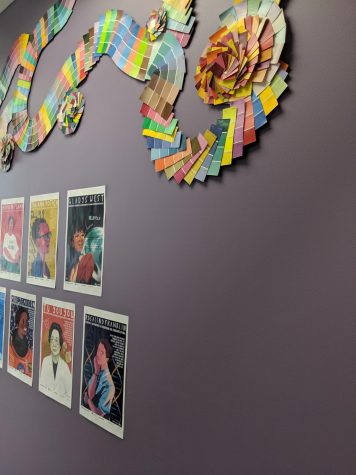A Hacker Haven for All: Rewiring the Capitol
DC is not generally considered an “innovative” city. Despite the young, ambitious would-be movers and shakers in the District’s universities and internship programs, it is known as stodgy and bureaucratic. HACDC, the District’s only hackerspace, a group of hackers, hobbyists, artists and engineers, are gearing up to change that.
From the outside, HACDC’s space in Columbia Heights is unassuming. Inside, the cluttered workspace is strewn with wires, motherboards, gutted musical instruments, mangled bike frames and half-finished schematics. Photos of the earth’s atmosphere, taken from “space blimps” or converted old coolers launched into near-space with weather balloons, cover the walls. It looks like the shared space of a carpenter, a mad scientist and a performance artist, none of whom agree on an organizational strategy.
Hackerspaces began to emerge over a decade ago, descendants of the “hacklabs” of the 90s that provided free access to Internet and programming software. The anarchist leanings of many hacklab founders, however, hindered the movement’s growth. While they continue to appeal to code junkies, they are attracting an increasingly varied crowd–leading to a reemergence of hackerspaces in the US.
“There are things that are the same about a lot of hackerspaces, but they usually differ in terms of governance,” said Ben Mendis who, until recently, was HACDC’s acting president. “A hackerspace is a reflection of the community that it’s in.” Since 2008, HACDC has attracted techies, artists, and DIY types to its Columbia Heights site.
Monday nights are Microcontroller Mondays at St. Stephen and the Incarnation Episcopal Church. While it’s not HACDC’s most-attended weeknight, it has a dedicated following of tinkerers who are interested in robotics. Each weeknight has a different theme. Some play host to guest speakers and member-led seminars, but most attract their regular crowd– a mix of hobbyists and experts who need space to work on their projects. Group members and guests lead workshops on everything from programming to fine art to bicycle repair.
When it’s not serving as a communal learning space, HACDC’s members are busy collaborating on their own pet projects. Since 2008, members have created art, published a book and programmed a network designed to help disaster victims.
Among their most impressive feats is the Mirage355 Biosignal Amplifier. Completed in late December 2013, a collaborative, near year-long project of several HACDC members, it is capable of detecting even the minutest changes in brain, heart, and muscular activity. Despite the fact that it was made communally without the financial backing of investors or a major company, it exceeds industry standards.
“One of the problems with other biosignal amplifiers is that it’s hard to distinguish what’s just noise if you don’t have a specific problem you’re looking for,” said Matthew Hines, known in hacker circles as Mirage355, who first brought the concept to HACDC. “Our amplifier has a lower noise floor; ours makes it easier to determine what’s just noise and what’s an actual signal.”
Hines developed a similar device before reaching out to HACDC. In HACDC, however, he saw an attractive community of equal parts savvy and a willingness to experiment. The biosignal amplifier team consisted of both professional tech experts and weekend warriors, some of whom didn’t develop an interest in biohacking or programming until well after their formal education.
Although the inner workings of each hackerspace varies, they share a commitment to open membership, not discriminating based on experience in the field or credentials. Because of this, Hines argues, hackerspaces serve as a home for unconventional learning.
“The best model of learning, I’ve found, is giving people a problem to solve and having them learn along the way,” Hines said. “The people at HACDC aren’t paid to teach, but are experts actively engaged in their own projects. People can come to these spaces to get the resources they need, human and otherwise, to complete projects on their own and further their skills.”
Mendis expressed a similar optimism about hackerspaces as teaching tools. But he encourages HACDC to make an even greater effort to branch out.
Despite the impressive contributions of amateaur hackers, “HACDC has kind of a reputation for being an ‘expert’s space,’” he said. “People tend to feel intimidated. By and large, most of our members are focused on working on projects and forming a community of experts. I’ve been pushing for more teaching and outreach, because it’s important to get a broader mix of perspectives into the space.”
Mendis may soon see his hopes realized. HACDC is generating a substantial buzz in the capital. In April, the White House itself will host this year’s annual Maker’s Faire, an event for hobbyists and experts alike to showcase their gadgetry. Audience members will include government and private organizations looking to capitalize on the curiosity and innovation, as well as the curious and innovate public. According to the White House’s blogged announcement of the event, the showcase will display every-day Americans’ ingenuity in order to encourage entrepreneurship, especially in science and math and especially among young people.
“People tend to feel intimidated. By and large, most of our members are focused on working on projects and forming a community of experts.”
The self-directed, community oriented approach of hackerspaces offers an enticing alternative to conventional education. People are free to try, fail, and fiddle at their own rate. Learning through collaboration offers a chance to gain the skills without staggering tuition fees or constrictive deadlines. HACDC is a blank slate bustling with tools, opportunities, and energy.
HACDC shows another side of the District’s character, putting a spin on its notorious “drive.” It isn’t homogenous, but collective; its filled with driven people who are more curious than ambitious.
HACDC and the trend it is a part of proves that innovation isn’t limited to the big companies or the big investors. Innovation occurs wherever people have a collaborative space with an equal desire to learn and teach with others. HACDC builds such a resource from the ground up, and does so without snobbery or exclusivity. To anyone with interest and passion, they say, “Don’t be bored. Make something.”






